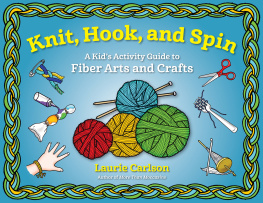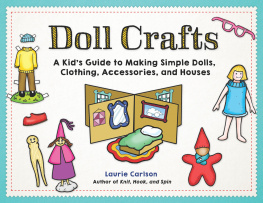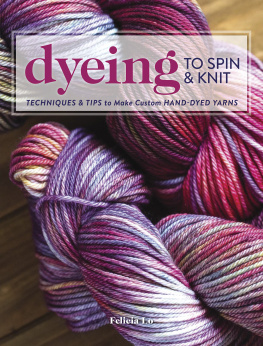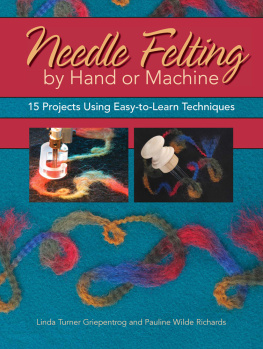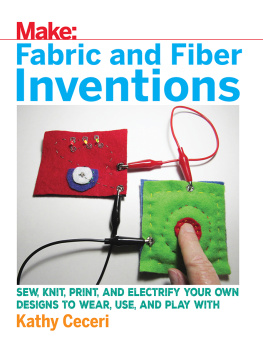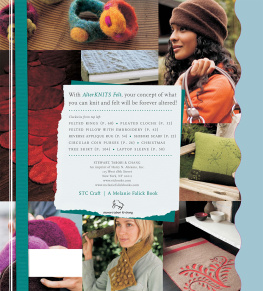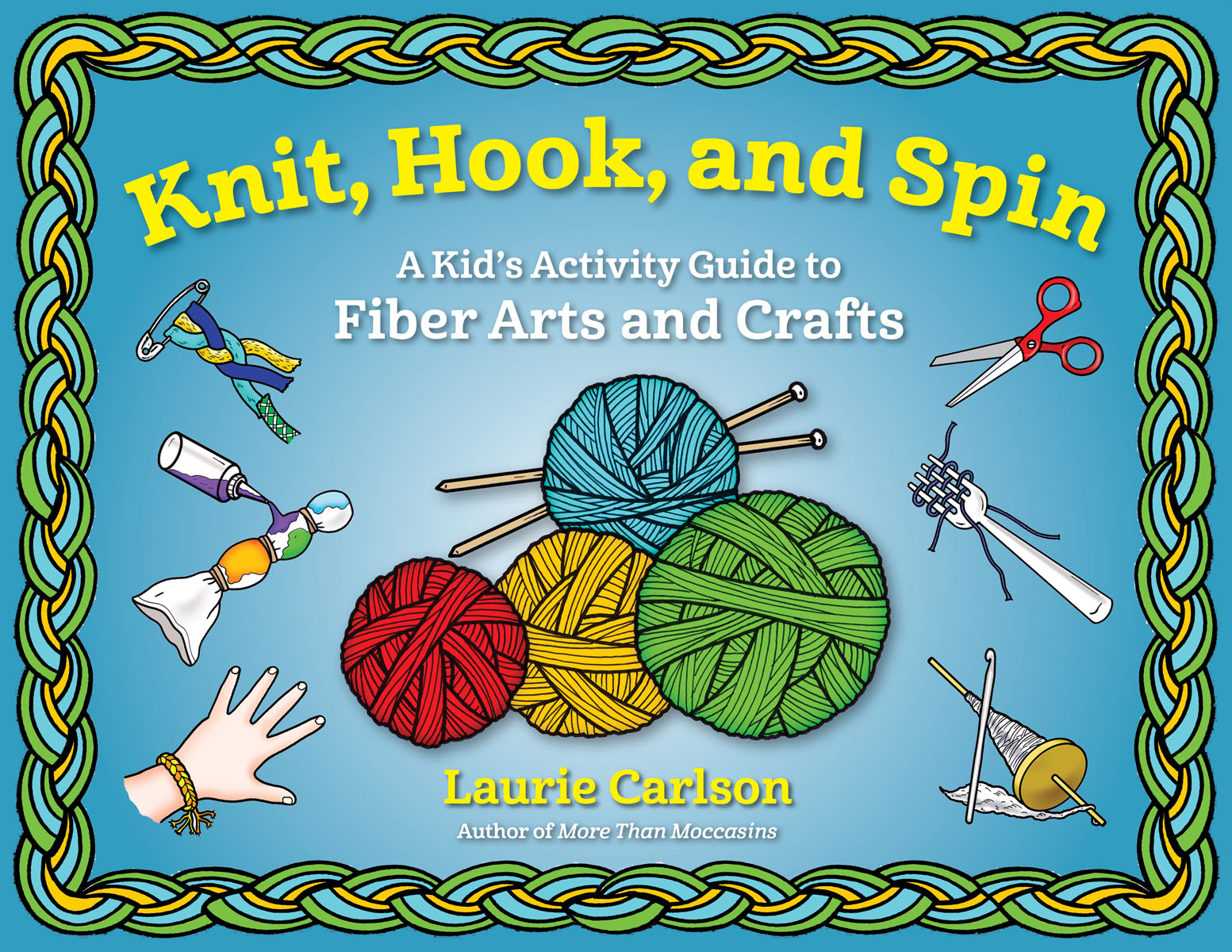
Copyright 2016 by Laurie Carlson
All rights reserved
Published by Chicago Review Press Incorporated
814 North Franklin Street
Chicago, Illinois 60610
ISBN 978-1-61373-400-1
Library of Congress Cataloging-in-Publication Data
Names: Carlson, Laurie M., 1952 author.
Title: Knit, hook, and spin : a kids activity guide to fiber arts and crafts / Laurie Carlson.
Description: Chicago, Illinois : Chicago Review Press Incorporated, [2016] | Audience: Age: 9+.
Identifiers: LCCN 2015044783 | ISBN 9781613734001 (trade paper)
Subjects: LCSH: Textile craftsJuvenile literature.
Classification: LCC TT712 .C37 2016 | DDC 745.5dc23 LC record available at http://lccn.loc.gov/2015044783
Cover design: Jonathan Hahn
Interior design: Sarah Olson
Cover and interior illustrations: Jim Spence
Printed in the United States of America
5 4 3 2 1
Contents



Introduction

W elcome to the wonderful world of fiber arts and crafts! People have been making things with fiber for thousands of years. Using fibers from animal hair or pieces of plants, people could make fishing lines and nets, blankets, tents, and clothing, allowing them to stay fed, warm, and sheltered.
Today, when machines seem to do everything for us, we dont have to create everything we wear or use. We can buy things we need. But millions of people still work with fiber because they enjoy making things with their hands. In fact, fiber arts and crafts are just as popular now as they ever were. At least 50 million people in the United States know how to knit and crochet.
What is fiber art, anyway? Fiber art is any art form that uses yarn or cloth or the fibers used tomake them. Because fabric and yarn are used so much in everyday clothing and household items, we tend to think of them as simply useful. In fact, they can also be used to make art. Every item made of fabric and yarn was designed by someone. That person decided on the color, texture, and pattern, as well as the shape of the finished item.
When you work with fiber you use a lot of different skills. Math is important, because youll be measuring length, making patterns of odds and evens, working with geometry and shape, and thinking about amounts, such as more, less, and equal. Youll also work with counting, and comparing top and bottom, in and out, over and under, above and below, and front and back. Whew! It sounds complicated, but it is easy and fun.
Here are a few tips for enjoying your fiber arts adventure:
- Choose simple projects that dont take a long time to finish.
- Collect yarn, cloth scraps, felt, and fiber stuff in a variety of colors and store them in a box so you have a stash to create with.
- Dont expect that your projects will be perfect every time. If something doesnt please you, change it, unravel it, or take it apart and try something else.
- Enjoy the items you make. Wear the things you make. Display them in your room. Give them to people you care about.

Why Fiber Handcrafts Are Good for You
You may not think that making things with yarn or fiber would make you smarter or keep you healthy, but it can. Working with fibers and yarn feels good to our sense of touch, and the colors and patterns please the eye. Our senses are sharpened, and that makes us feel happier. Doing handwork, like knitting or crocheting, helps us relax. It also helps us focus and pay attention better. Because following written directions stretches our brain, its good for our thinking skills. And you can also make changes to a project that make it your own, expressing your creativity.
Some people find that knitting or crocheting helps when they are ill or in pain. Some find that it helps them sleep better at night. Handcrafts take time and attention, so we learn to be more patient and less restless. Youll also figure out how to solve problems when something doesnt seem to be turning out as you thought it would. But best of all, when you are finished with a project, you have a feeling of pride. And lots of gifts to give your friends.
Know Your Fibers

F iber is the basic ingredient in craftingsort of like flour for a baker and soil for a gardener. Fibers are thin strands of plant stems (linen), fluff from seed pods (cotton), animal hair (wool), or tiny strands of plastic (acrylic) that are twisted together to make yarn. Fiber can be as thin as sewing thread or as thick as rope. But before fibers can be twisted together, a lot of preparation must be done. Fibers from plants or animals must be clipped, washed, fluffed, combed, and dyed.
Fibers create different types of finished projects. Whether your project will be silky, soft, stretchy, shiny, or warm is determined by the type of fiber. Some fibers can be scratchylike juteand are best for ropes or sacks. Do you want something soft and luxurious? Use angora rabbit. Shiny? Well, thats silk or mohair. Washable and nonallergenic? Try synthetics. Warm and fireproof? Thats a job for wool. The more you know about fibers, the easier it will be for you to match the right fiber to your project.
Plant Fibers
People used plant fibers long before they discovered any of the others. They plucked grassy stems, strips of stringy tree bark, and long skinny leaves from the natural world around them. They did things to the pieces of bark or leaves to make them easier to bend and shape to suit what they wanted to make. They were processing the fiber, making it both easier to work with and longer lasting once a project was complete.
From those plant fibers, people made nets and ropes that made it easier to catch fish, birds, and small animals for food. They made mats that they used as roofing on their homes and for sleeping pads. Listed here are the plants most commonly used in fiber and fabric today.
COTTON
Cotton is a fluffy fiber that comes from the boll, or flower, of the cotton plant. It was grown in Egypt, Asia, and South America for 6,000 years. It was grown by Native Americans in North America and became a valuable farming product in the southern United States about 200 years ago. Northern Europeans relied on sheeps wool, because cotton plants didnt grow well in their cold climate. People there called cotton tree wool, because the fluffy puffs of fiber looked like pieces of sheeps wool stuck on a branch.
FLAX (LINEN)
The fibers of the flax plant are used to make a fabric called linen. It is a lot of work to get flax ready to spin. The full-grown plant is pulled from the earth, with the roots hanging. Then a rough comb is pulled through the stem to remove the seeds. The stem part is soaked in water for a few weeks until it begins to rot. Then it is dried in the sun. Next, the flax stems are beaten against a board and combed with metal combs. Finally, the strands can be separated from each other and spun into linen thread, ready for knitting or weaving.
Next page
